Analysis of Social Determinants Influencing Heart Disease in Australia
VerifiedAdded on 2023/06/03
|14
|2893
|346
Report
AI Summary
This report provides a comprehensive analysis of the social determinants of heart-related issues in Australia, examining the interplay of various factors such as population patterns, morbidity, and mortality rates. It delves into the impact of behavioral, environmental, and social determinants on the health of the Australian population, with a specific focus on the influence of socioeconomic status. The report explores the causes of cardiovascular disease, including smoking, cholesterol levels, high blood pressure, physical inactivity, diabetes, and obesity. It highlights the social gradient of health, emphasizing how those with lower socioeconomic status are more prone to increased behavioral risk factors for heart disease, leading to health inequalities. The report also provides recommendations for addressing these inequalities, including a whole-of-government approach and interventions to empower individuals and reduce health disparities. The report concludes with a call for involvement from sectors beyond health to tackle the root causes of heart disease and improve overall public health outcomes.

[SOCIAL DETERMINANTS OF HEALTH]
Paraphrase This Document
Need a fresh take? Get an instant paraphrase of this document with our AI Paraphraser
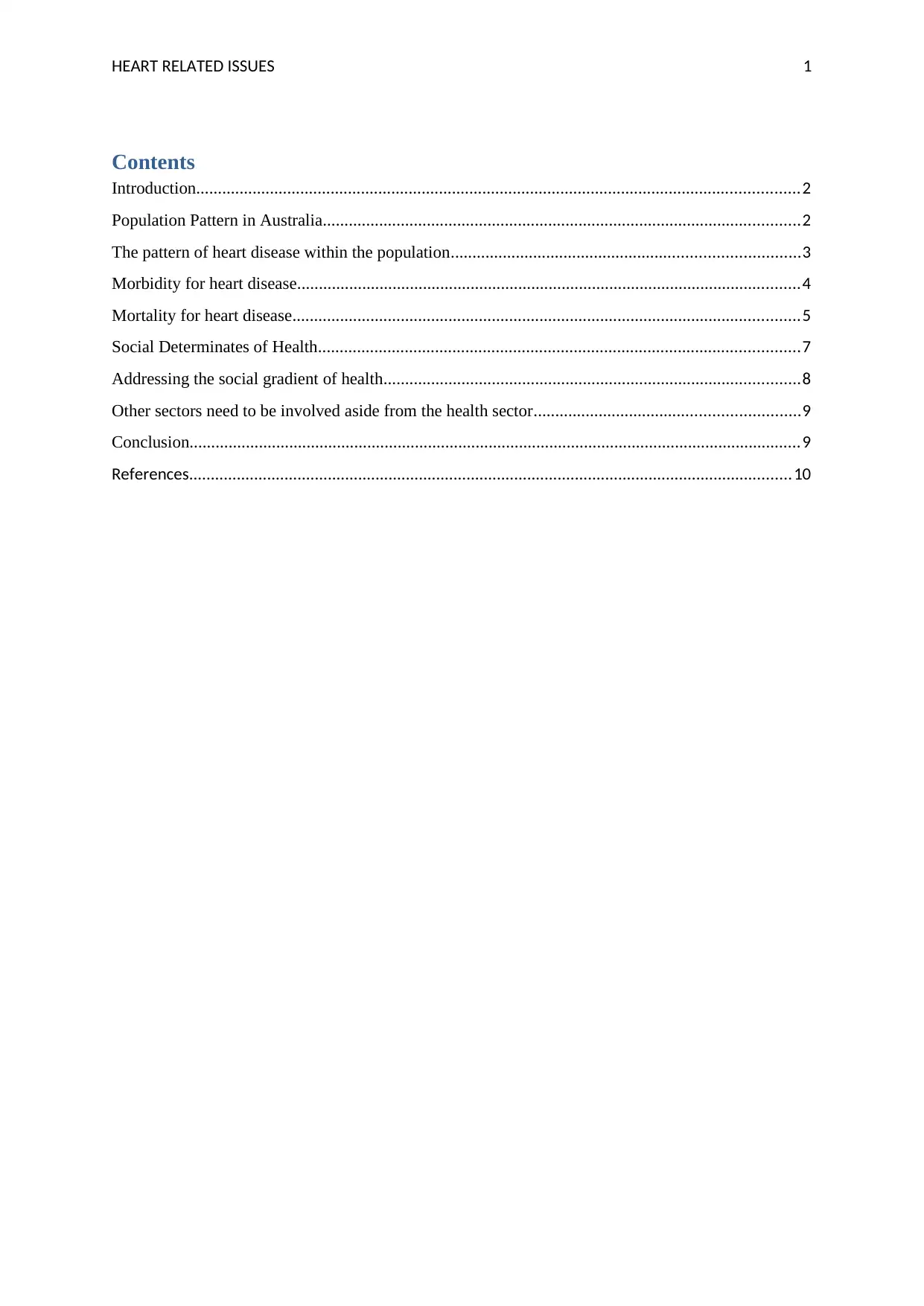
HEART RELATED ISSUES 1
Contents
Introduction...........................................................................................................................................2
Population Pattern in Australia..............................................................................................................2
The pattern of heart disease within the population................................................................................3
Morbidity for heart disease....................................................................................................................4
Mortality for heart disease.....................................................................................................................5
Social Determinates of Health...............................................................................................................7
Addressing the social gradient of health................................................................................................8
Other sectors need to be involved aside from the health sector.............................................................9
Conclusion.............................................................................................................................................9
References...........................................................................................................................................10
Contents
Introduction...........................................................................................................................................2
Population Pattern in Australia..............................................................................................................2
The pattern of heart disease within the population................................................................................3
Morbidity for heart disease....................................................................................................................4
Mortality for heart disease.....................................................................................................................5
Social Determinates of Health...............................................................................................................7
Addressing the social gradient of health................................................................................................8
Other sectors need to be involved aside from the health sector.............................................................9
Conclusion.............................................................................................................................................9
References...........................................................................................................................................10
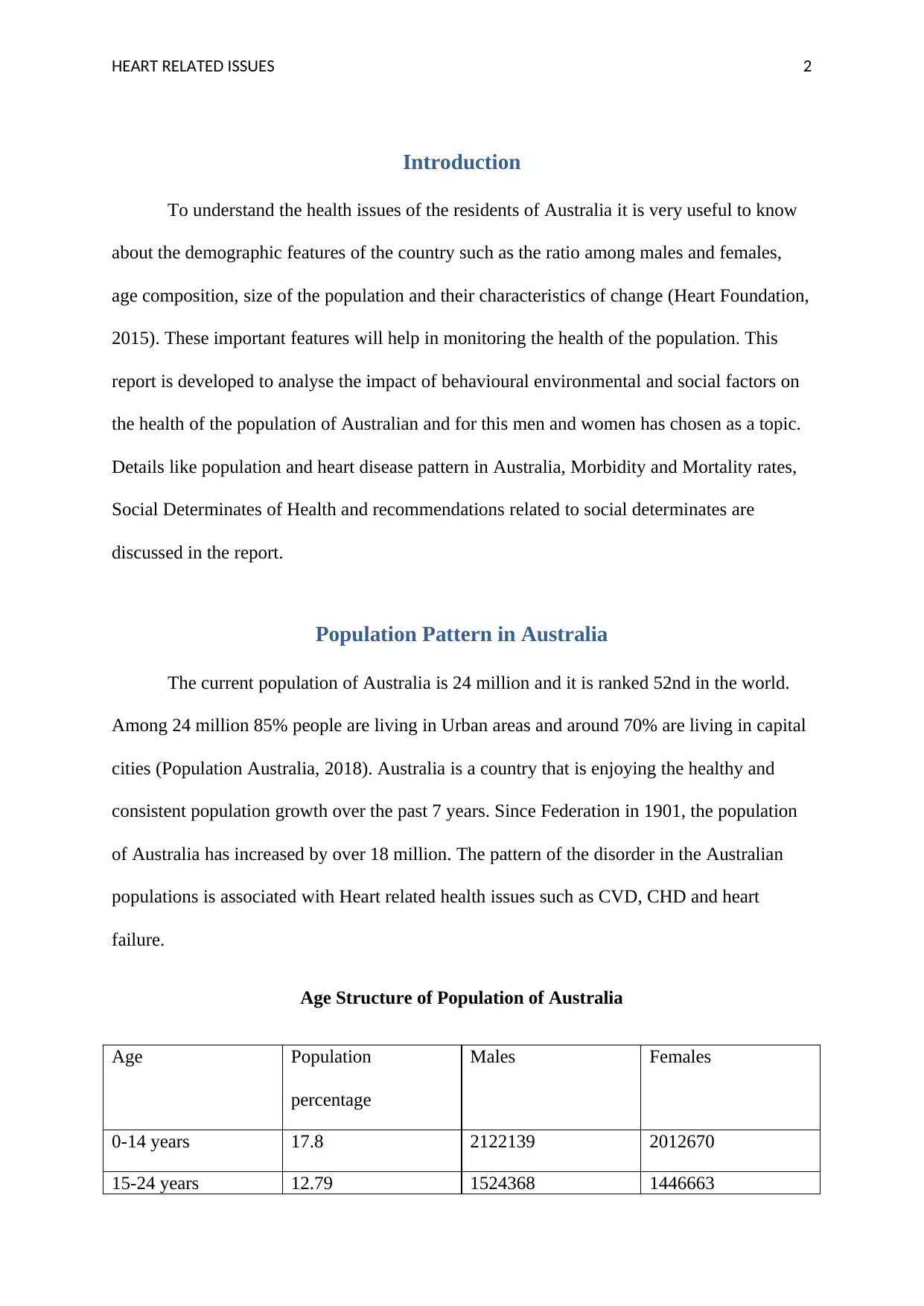
HEART RELATED ISSUES 2
Introduction
To understand the health issues of the residents of Australia it is very useful to know
about the demographic features of the country such as the ratio among males and females,
age composition, size of the population and their characteristics of change (Heart Foundation,
2015). These important features will help in monitoring the health of the population. This
report is developed to analyse the impact of behavioural environmental and social factors on
the health of the population of Australian and for this men and women has chosen as a topic.
Details like population and heart disease pattern in Australia, Morbidity and Mortality rates,
Social Determinates of Health and recommendations related to social determinates are
discussed in the report.
Population Pattern in Australia
The current population of Australia is 24 million and it is ranked 52nd in the world.
Among 24 million 85% people are living in Urban areas and around 70% are living in capital
cities (Population Australia, 2018). Australia is a country that is enjoying the healthy and
consistent population growth over the past 7 years. Since Federation in 1901, the population
of Australia has increased by over 18 million. The pattern of the disorder in the Australian
populations is associated with Heart related health issues such as CVD, CHD and heart
failure.
Age Structure of Population of Australia
Age Population
percentage
Males Females
0-14 years 17.8 2122139 2012670
15-24 years 12.79 1524368 1446663
Introduction
To understand the health issues of the residents of Australia it is very useful to know
about the demographic features of the country such as the ratio among males and females,
age composition, size of the population and their characteristics of change (Heart Foundation,
2015). These important features will help in monitoring the health of the population. This
report is developed to analyse the impact of behavioural environmental and social factors on
the health of the population of Australian and for this men and women has chosen as a topic.
Details like population and heart disease pattern in Australia, Morbidity and Mortality rates,
Social Determinates of Health and recommendations related to social determinates are
discussed in the report.
Population Pattern in Australia
The current population of Australia is 24 million and it is ranked 52nd in the world.
Among 24 million 85% people are living in Urban areas and around 70% are living in capital
cities (Population Australia, 2018). Australia is a country that is enjoying the healthy and
consistent population growth over the past 7 years. Since Federation in 1901, the population
of Australia has increased by over 18 million. The pattern of the disorder in the Australian
populations is associated with Heart related health issues such as CVD, CHD and heart
failure.
Age Structure of Population of Australia
Age Population
percentage
Males Females
0-14 years 17.8 2122139 2012670
15-24 years 12.79 1524368 1446663
⊘ This is a preview!⊘
Do you want full access?
Subscribe today to unlock all pages.

Trusted by 1+ million students worldwide
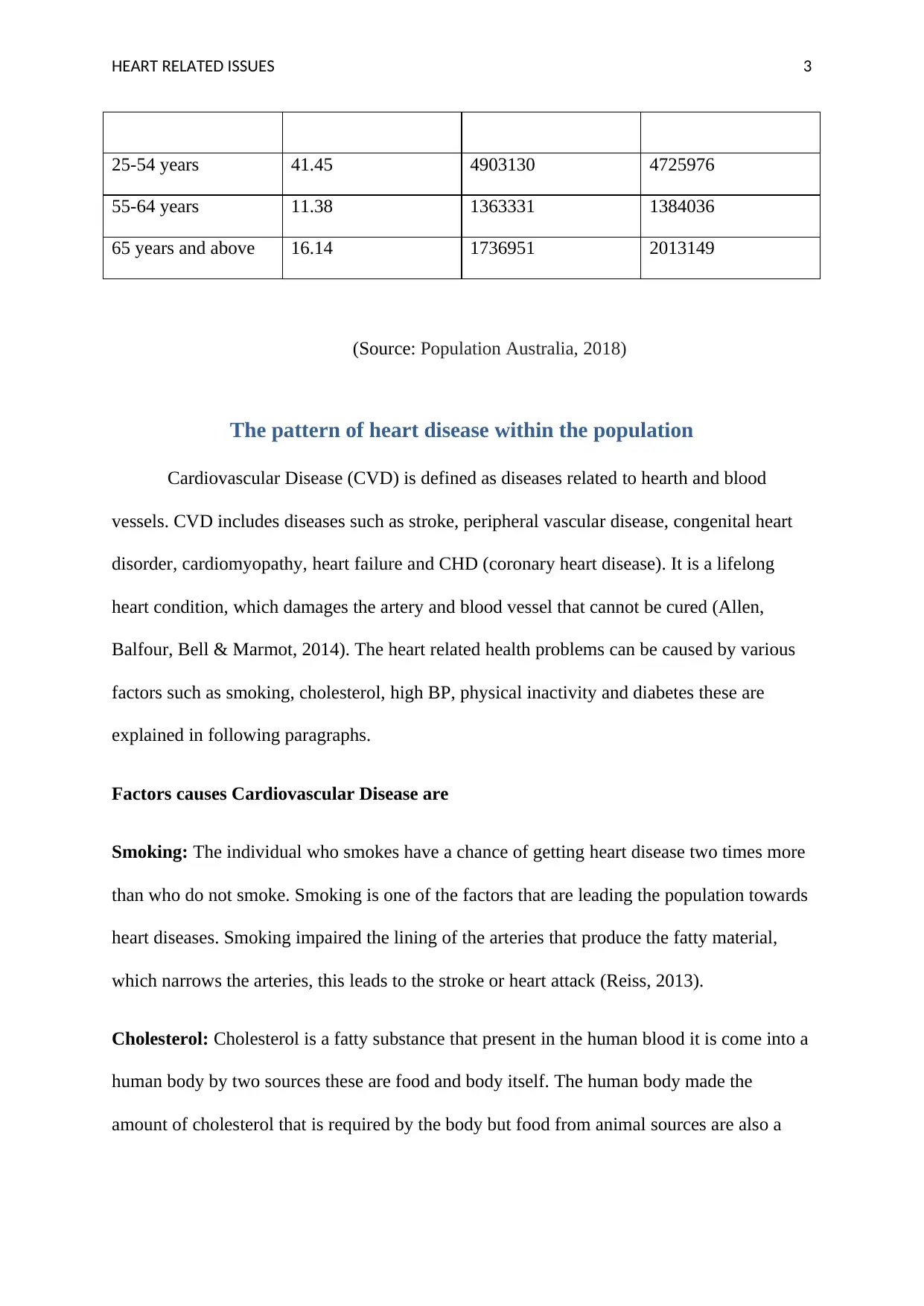
HEART RELATED ISSUES 3
25-54 years 41.45 4903130 4725976
55-64 years 11.38 1363331 1384036
65 years and above 16.14 1736951 2013149
(Source: Population Australia, 2018)
The pattern of heart disease within the population
Cardiovascular Disease (CVD) is defined as diseases related to hearth and blood
vessels. CVD includes diseases such as stroke, peripheral vascular disease, congenital heart
disorder, cardiomyopathy, heart failure and CHD (coronary heart disease). It is a lifelong
heart condition, which damages the artery and blood vessel that cannot be cured (Allen,
Balfour, Bell & Marmot, 2014). The heart related health problems can be caused by various
factors such as smoking, cholesterol, high BP, physical inactivity and diabetes these are
explained in following paragraphs.
Factors causes Cardiovascular Disease are
Smoking: The individual who smokes have a chance of getting heart disease two times more
than who do not smoke. Smoking is one of the factors that are leading the population towards
heart diseases. Smoking impaired the lining of the arteries that produce the fatty material,
which narrows the arteries, this leads to the stroke or heart attack (Reiss, 2013).
Cholesterol: Cholesterol is a fatty substance that present in the human blood it is come into a
human body by two sources these are food and body itself. The human body made the
amount of cholesterol that is required by the body but food from animal sources are also a
25-54 years 41.45 4903130 4725976
55-64 years 11.38 1363331 1384036
65 years and above 16.14 1736951 2013149
(Source: Population Australia, 2018)
The pattern of heart disease within the population
Cardiovascular Disease (CVD) is defined as diseases related to hearth and blood
vessels. CVD includes diseases such as stroke, peripheral vascular disease, congenital heart
disorder, cardiomyopathy, heart failure and CHD (coronary heart disease). It is a lifelong
heart condition, which damages the artery and blood vessel that cannot be cured (Allen,
Balfour, Bell & Marmot, 2014). The heart related health problems can be caused by various
factors such as smoking, cholesterol, high BP, physical inactivity and diabetes these are
explained in following paragraphs.
Factors causes Cardiovascular Disease are
Smoking: The individual who smokes have a chance of getting heart disease two times more
than who do not smoke. Smoking is one of the factors that are leading the population towards
heart diseases. Smoking impaired the lining of the arteries that produce the fatty material,
which narrows the arteries, this leads to the stroke or heart attack (Reiss, 2013).
Cholesterol: Cholesterol is a fatty substance that present in the human blood it is come into a
human body by two sources these are food and body itself. The human body made the
amount of cholesterol that is required by the body but food from animal sources are also a
Paraphrase This Document
Need a fresh take? Get an instant paraphrase of this document with our AI Paraphraser
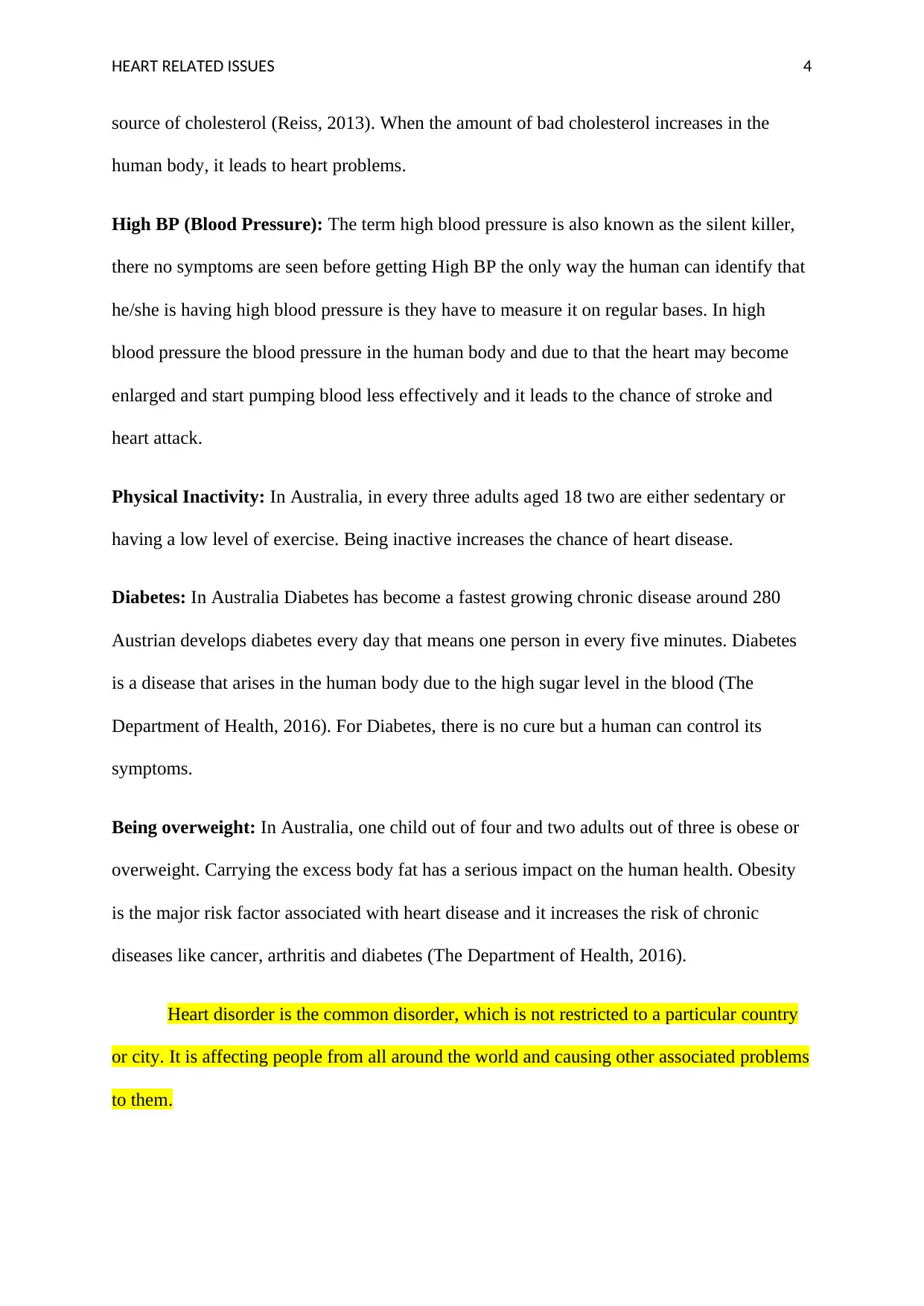
HEART RELATED ISSUES 4
source of cholesterol (Reiss, 2013). When the amount of bad cholesterol increases in the
human body, it leads to heart problems.
High BP (Blood Pressure): The term high blood pressure is also known as the silent killer,
there no symptoms are seen before getting High BP the only way the human can identify that
he/she is having high blood pressure is they have to measure it on regular bases. In high
blood pressure the blood pressure in the human body and due to that the heart may become
enlarged and start pumping blood less effectively and it leads to the chance of stroke and
heart attack.
Physical Inactivity: In Australia, in every three adults aged 18 two are either sedentary or
having a low level of exercise. Being inactive increases the chance of heart disease.
Diabetes: In Australia Diabetes has become a fastest growing chronic disease around 280
Austrian develops diabetes every day that means one person in every five minutes. Diabetes
is a disease that arises in the human body due to the high sugar level in the blood (The
Department of Health, 2016). For Diabetes, there is no cure but a human can control its
symptoms.
Being overweight: In Australia, one child out of four and two adults out of three is obese or
overweight. Carrying the excess body fat has a serious impact on the human health. Obesity
is the major risk factor associated with heart disease and it increases the risk of chronic
diseases like cancer, arthritis and diabetes (The Department of Health, 2016).
Heart disorder is the common disorder, which is not restricted to a particular country
or city. It is affecting people from all around the world and causing other associated problems
to them.
source of cholesterol (Reiss, 2013). When the amount of bad cholesterol increases in the
human body, it leads to heart problems.
High BP (Blood Pressure): The term high blood pressure is also known as the silent killer,
there no symptoms are seen before getting High BP the only way the human can identify that
he/she is having high blood pressure is they have to measure it on regular bases. In high
blood pressure the blood pressure in the human body and due to that the heart may become
enlarged and start pumping blood less effectively and it leads to the chance of stroke and
heart attack.
Physical Inactivity: In Australia, in every three adults aged 18 two are either sedentary or
having a low level of exercise. Being inactive increases the chance of heart disease.
Diabetes: In Australia Diabetes has become a fastest growing chronic disease around 280
Austrian develops diabetes every day that means one person in every five minutes. Diabetes
is a disease that arises in the human body due to the high sugar level in the blood (The
Department of Health, 2016). For Diabetes, there is no cure but a human can control its
symptoms.
Being overweight: In Australia, one child out of four and two adults out of three is obese or
overweight. Carrying the excess body fat has a serious impact on the human health. Obesity
is the major risk factor associated with heart disease and it increases the risk of chronic
diseases like cancer, arthritis and diabetes (The Department of Health, 2016).
Heart disorder is the common disorder, which is not restricted to a particular country
or city. It is affecting people from all around the world and causing other associated problems
to them.
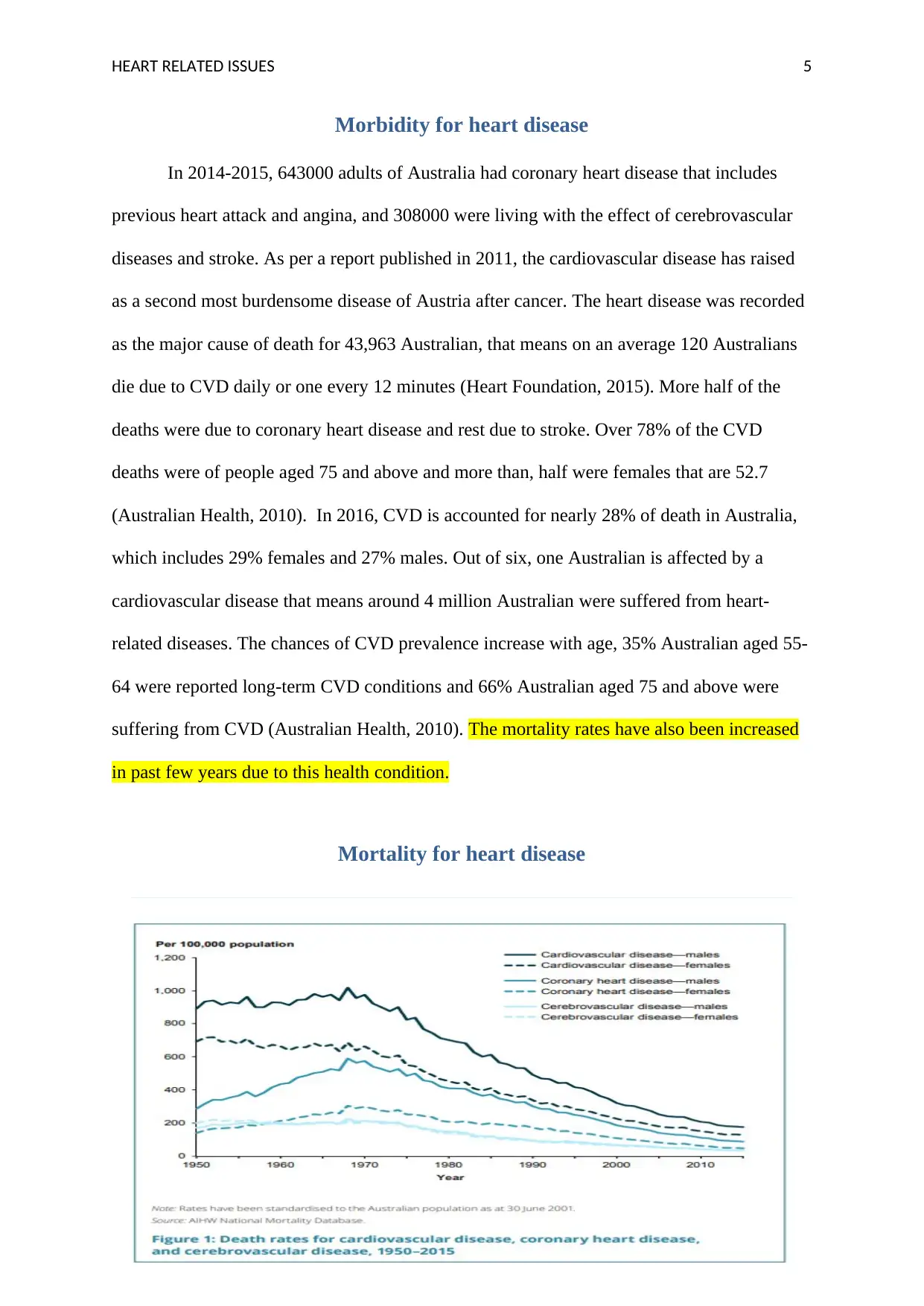
HEART RELATED ISSUES 5
Morbidity for heart disease
In 2014-2015, 643000 adults of Australia had coronary heart disease that includes
previous heart attack and angina, and 308000 were living with the effect of cerebrovascular
diseases and stroke. As per a report published in 2011, the cardiovascular disease has raised
as a second most burdensome disease of Austria after cancer. The heart disease was recorded
as the major cause of death for 43,963 Australian, that means on an average 120 Australians
die due to CVD daily or one every 12 minutes (Heart Foundation, 2015). More half of the
deaths were due to coronary heart disease and rest due to stroke. Over 78% of the CVD
deaths were of people aged 75 and above and more than, half were females that are 52.7
(Australian Health, 2010). In 2016, CVD is accounted for nearly 28% of death in Australia,
which includes 29% females and 27% males. Out of six, one Australian is affected by a
cardiovascular disease that means around 4 million Australian were suffered from heart-
related diseases. The chances of CVD prevalence increase with age, 35% Australian aged 55-
64 were reported long-term CVD conditions and 66% Australian aged 75 and above were
suffering from CVD (Australian Health, 2010). The mortality rates have also been increased
in past few years due to this health condition.
Mortality for heart disease
Morbidity for heart disease
In 2014-2015, 643000 adults of Australia had coronary heart disease that includes
previous heart attack and angina, and 308000 were living with the effect of cerebrovascular
diseases and stroke. As per a report published in 2011, the cardiovascular disease has raised
as a second most burdensome disease of Austria after cancer. The heart disease was recorded
as the major cause of death for 43,963 Australian, that means on an average 120 Australians
die due to CVD daily or one every 12 minutes (Heart Foundation, 2015). More half of the
deaths were due to coronary heart disease and rest due to stroke. Over 78% of the CVD
deaths were of people aged 75 and above and more than, half were females that are 52.7
(Australian Health, 2010). In 2016, CVD is accounted for nearly 28% of death in Australia,
which includes 29% females and 27% males. Out of six, one Australian is affected by a
cardiovascular disease that means around 4 million Australian were suffered from heart-
related diseases. The chances of CVD prevalence increase with age, 35% Australian aged 55-
64 were reported long-term CVD conditions and 66% Australian aged 75 and above were
suffering from CVD (Australian Health, 2010). The mortality rates have also been increased
in past few years due to this health condition.
Mortality for heart disease
⊘ This is a preview!⊘
Do you want full access?
Subscribe today to unlock all pages.

Trusted by 1+ million students worldwide
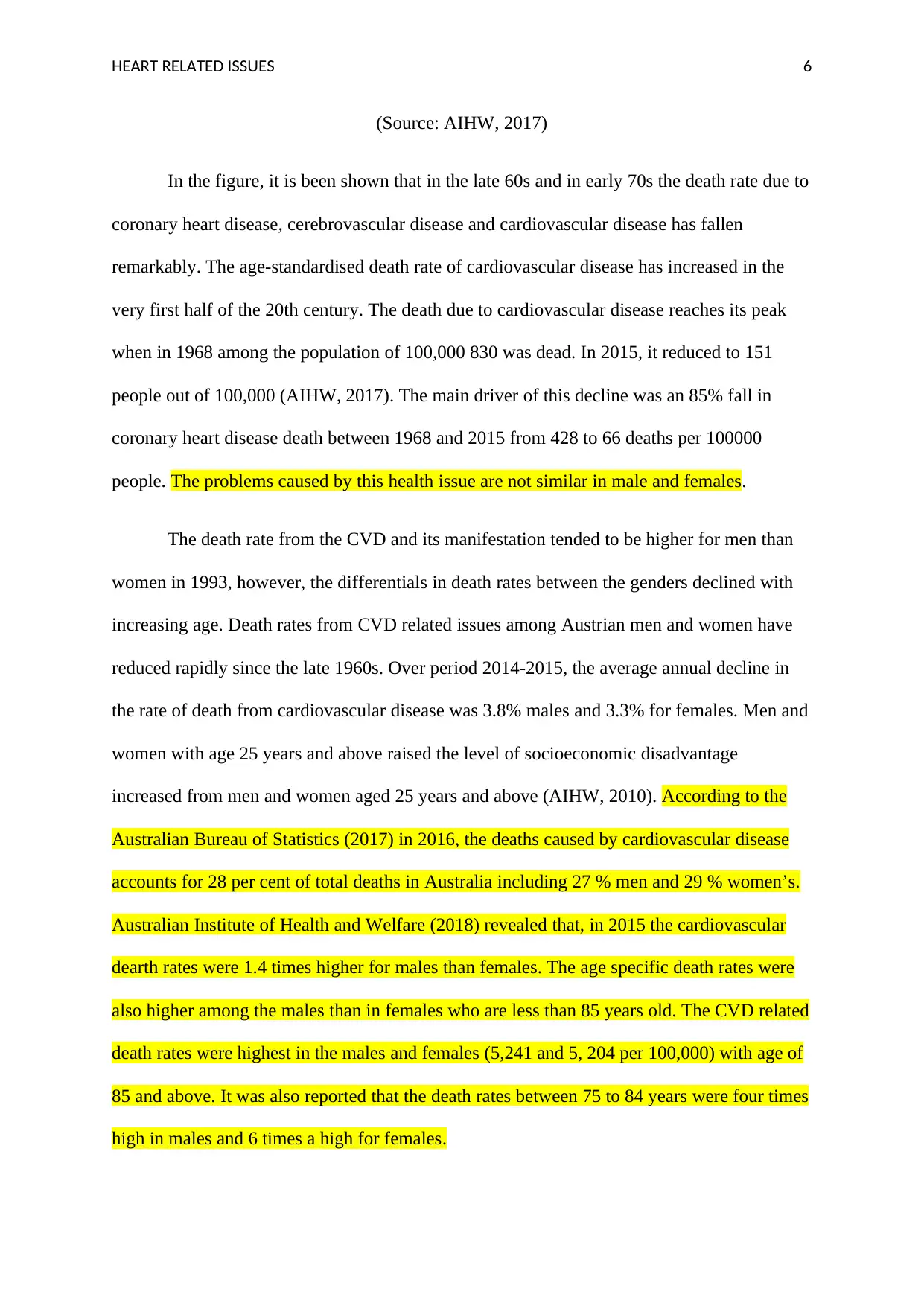
HEART RELATED ISSUES 6
(Source: AIHW, 2017)
In the figure, it is been shown that in the late 60s and in early 70s the death rate due to
coronary heart disease, cerebrovascular disease and cardiovascular disease has fallen
remarkably. The age-standardised death rate of cardiovascular disease has increased in the
very first half of the 20th century. The death due to cardiovascular disease reaches its peak
when in 1968 among the population of 100,000 830 was dead. In 2015, it reduced to 151
people out of 100,000 (AIHW, 2017). The main driver of this decline was an 85% fall in
coronary heart disease death between 1968 and 2015 from 428 to 66 deaths per 100000
people. The problems caused by this health issue are not similar in male and females.
The death rate from the CVD and its manifestation tended to be higher for men than
women in 1993, however, the differentials in death rates between the genders declined with
increasing age. Death rates from CVD related issues among Austrian men and women have
reduced rapidly since the late 1960s. Over period 2014-2015, the average annual decline in
the rate of death from cardiovascular disease was 3.8% males and 3.3% for females. Men and
women with age 25 years and above raised the level of socioeconomic disadvantage
increased from men and women aged 25 years and above (AIHW, 2010). According to the
Australian Bureau of Statistics (2017) in 2016, the deaths caused by cardiovascular disease
accounts for 28 per cent of total deaths in Australia including 27 % men and 29 % women’s.
Australian Institute of Health and Welfare (2018) revealed that, in 2015 the cardiovascular
dearth rates were 1.4 times higher for males than females. The age specific death rates were
also higher among the males than in females who are less than 85 years old. The CVD related
death rates were highest in the males and females (5,241 and 5, 204 per 100,000) with age of
85 and above. It was also reported that the death rates between 75 to 84 years were four times
high in males and 6 times a high for females.
(Source: AIHW, 2017)
In the figure, it is been shown that in the late 60s and in early 70s the death rate due to
coronary heart disease, cerebrovascular disease and cardiovascular disease has fallen
remarkably. The age-standardised death rate of cardiovascular disease has increased in the
very first half of the 20th century. The death due to cardiovascular disease reaches its peak
when in 1968 among the population of 100,000 830 was dead. In 2015, it reduced to 151
people out of 100,000 (AIHW, 2017). The main driver of this decline was an 85% fall in
coronary heart disease death between 1968 and 2015 from 428 to 66 deaths per 100000
people. The problems caused by this health issue are not similar in male and females.
The death rate from the CVD and its manifestation tended to be higher for men than
women in 1993, however, the differentials in death rates between the genders declined with
increasing age. Death rates from CVD related issues among Austrian men and women have
reduced rapidly since the late 1960s. Over period 2014-2015, the average annual decline in
the rate of death from cardiovascular disease was 3.8% males and 3.3% for females. Men and
women with age 25 years and above raised the level of socioeconomic disadvantage
increased from men and women aged 25 years and above (AIHW, 2010). According to the
Australian Bureau of Statistics (2017) in 2016, the deaths caused by cardiovascular disease
accounts for 28 per cent of total deaths in Australia including 27 % men and 29 % women’s.
Australian Institute of Health and Welfare (2018) revealed that, in 2015 the cardiovascular
dearth rates were 1.4 times higher for males than females. The age specific death rates were
also higher among the males than in females who are less than 85 years old. The CVD related
death rates were highest in the males and females (5,241 and 5, 204 per 100,000) with age of
85 and above. It was also reported that the death rates between 75 to 84 years were four times
high in males and 6 times a high for females.
Paraphrase This Document
Need a fresh take? Get an instant paraphrase of this document with our AI Paraphraser
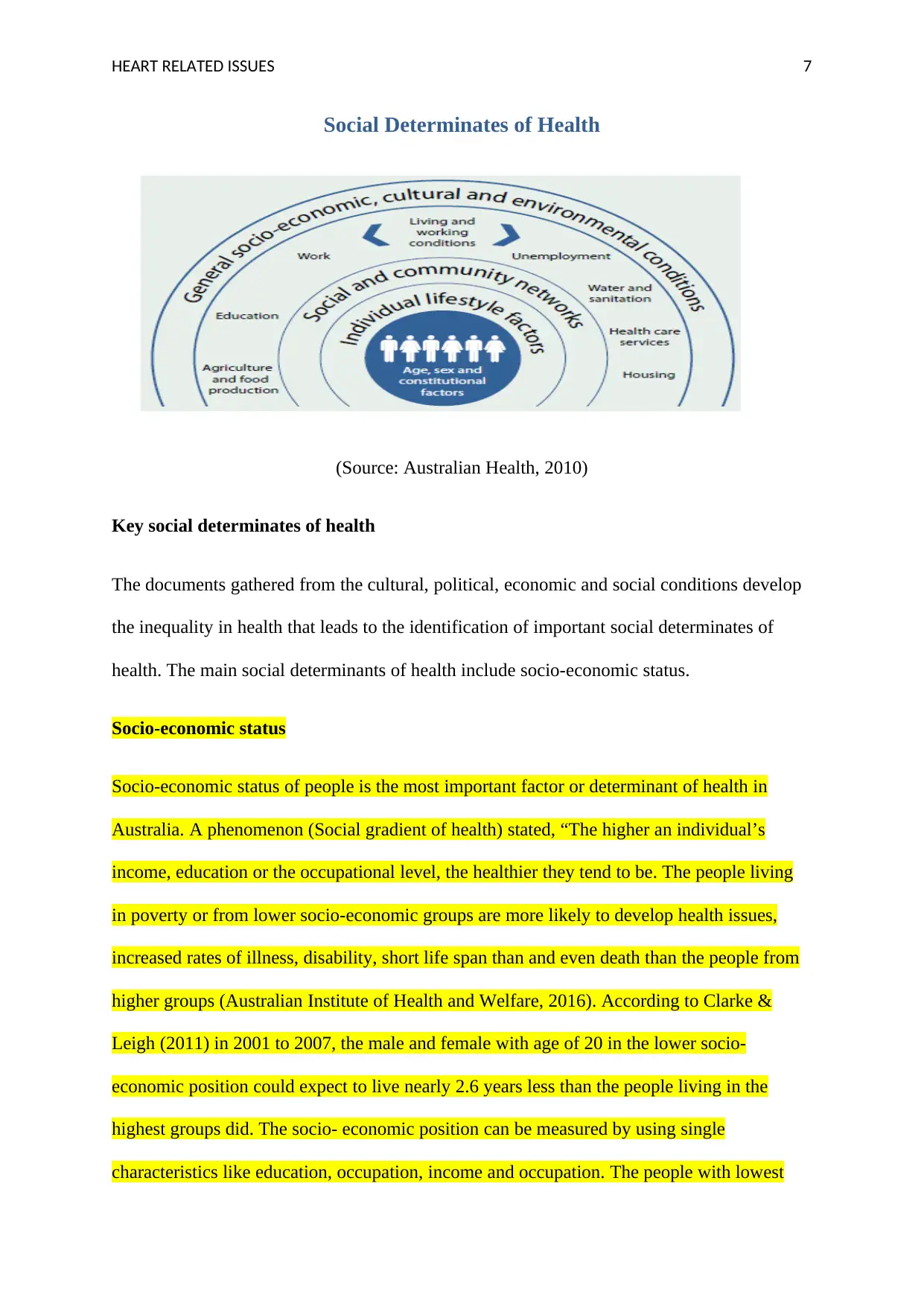
HEART RELATED ISSUES 7
Social Determinates of Health
(Source: Australian Health, 2010)
Key social determinates of health
The documents gathered from the cultural, political, economic and social conditions develop
the inequality in health that leads to the identification of important social determinates of
health. The main social determinants of health include socio-economic status.
Socio-economic status
Socio-economic status of people is the most important factor or determinant of health in
Australia. A phenomenon (Social gradient of health) stated, “The higher an individual’s
income, education or the occupational level, the healthier they tend to be. The people living
in poverty or from lower socio-economic groups are more likely to develop health issues,
increased rates of illness, disability, short life span than and even death than the people from
higher groups (Australian Institute of Health and Welfare, 2016). According to Clarke &
Leigh (2011) in 2001 to 2007, the male and female with age of 20 in the lower socio-
economic position could expect to live nearly 2.6 years less than the people living in the
highest groups did. The socio- economic position can be measured by using single
characteristics like education, occupation, income and occupation. The people with lowest
Social Determinates of Health
(Source: Australian Health, 2010)
Key social determinates of health
The documents gathered from the cultural, political, economic and social conditions develop
the inequality in health that leads to the identification of important social determinates of
health. The main social determinants of health include socio-economic status.
Socio-economic status
Socio-economic status of people is the most important factor or determinant of health in
Australia. A phenomenon (Social gradient of health) stated, “The higher an individual’s
income, education or the occupational level, the healthier they tend to be. The people living
in poverty or from lower socio-economic groups are more likely to develop health issues,
increased rates of illness, disability, short life span than and even death than the people from
higher groups (Australian Institute of Health and Welfare, 2016). According to Clarke &
Leigh (2011) in 2001 to 2007, the male and female with age of 20 in the lower socio-
economic position could expect to live nearly 2.6 years less than the people living in the
highest groups did. The socio- economic position can be measured by using single
characteristics like education, occupation, income and occupation. The people with lowest
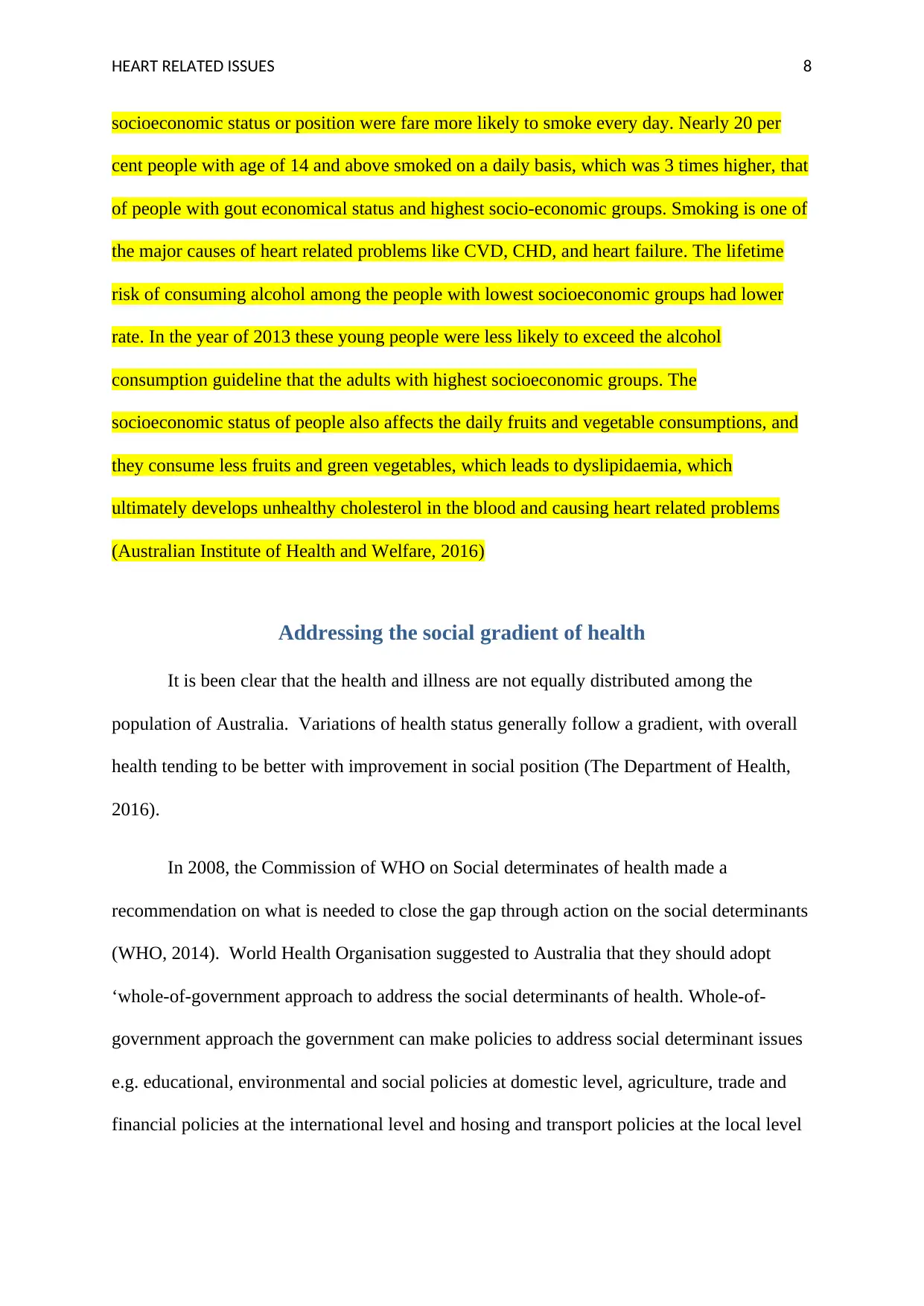
HEART RELATED ISSUES 8
socioeconomic status or position were fare more likely to smoke every day. Nearly 20 per
cent people with age of 14 and above smoked on a daily basis, which was 3 times higher, that
of people with gout economical status and highest socio-economic groups. Smoking is one of
the major causes of heart related problems like CVD, CHD, and heart failure. The lifetime
risk of consuming alcohol among the people with lowest socioeconomic groups had lower
rate. In the year of 2013 these young people were less likely to exceed the alcohol
consumption guideline that the adults with highest socioeconomic groups. The
socioeconomic status of people also affects the daily fruits and vegetable consumptions, and
they consume less fruits and green vegetables, which leads to dyslipidaemia, which
ultimately develops unhealthy cholesterol in the blood and causing heart related problems
(Australian Institute of Health and Welfare, 2016)
Addressing the social gradient of health
It is been clear that the health and illness are not equally distributed among the
population of Australia. Variations of health status generally follow a gradient, with overall
health tending to be better with improvement in social position (The Department of Health,
2016).
In 2008, the Commission of WHO on Social determinates of health made a
recommendation on what is needed to close the gap through action on the social determinants
(WHO, 2014). World Health Organisation suggested to Australia that they should adopt
‘whole-of-government approach to address the social determinants of health. Whole-of-
government approach the government can make policies to address social determinant issues
e.g. educational, environmental and social policies at domestic level, agriculture, trade and
financial policies at the international level and hosing and transport policies at the local level
socioeconomic status or position were fare more likely to smoke every day. Nearly 20 per
cent people with age of 14 and above smoked on a daily basis, which was 3 times higher, that
of people with gout economical status and highest socio-economic groups. Smoking is one of
the major causes of heart related problems like CVD, CHD, and heart failure. The lifetime
risk of consuming alcohol among the people with lowest socioeconomic groups had lower
rate. In the year of 2013 these young people were less likely to exceed the alcohol
consumption guideline that the adults with highest socioeconomic groups. The
socioeconomic status of people also affects the daily fruits and vegetable consumptions, and
they consume less fruits and green vegetables, which leads to dyslipidaemia, which
ultimately develops unhealthy cholesterol in the blood and causing heart related problems
(Australian Institute of Health and Welfare, 2016)
Addressing the social gradient of health
It is been clear that the health and illness are not equally distributed among the
population of Australia. Variations of health status generally follow a gradient, with overall
health tending to be better with improvement in social position (The Department of Health,
2016).
In 2008, the Commission of WHO on Social determinates of health made a
recommendation on what is needed to close the gap through action on the social determinants
(WHO, 2014). World Health Organisation suggested to Australia that they should adopt
‘whole-of-government approach to address the social determinants of health. Whole-of-
government approach the government can make policies to address social determinant issues
e.g. educational, environmental and social policies at domestic level, agriculture, trade and
financial policies at the international level and hosing and transport policies at the local level
⊘ This is a preview!⊘
Do you want full access?
Subscribe today to unlock all pages.

Trusted by 1+ million students worldwide
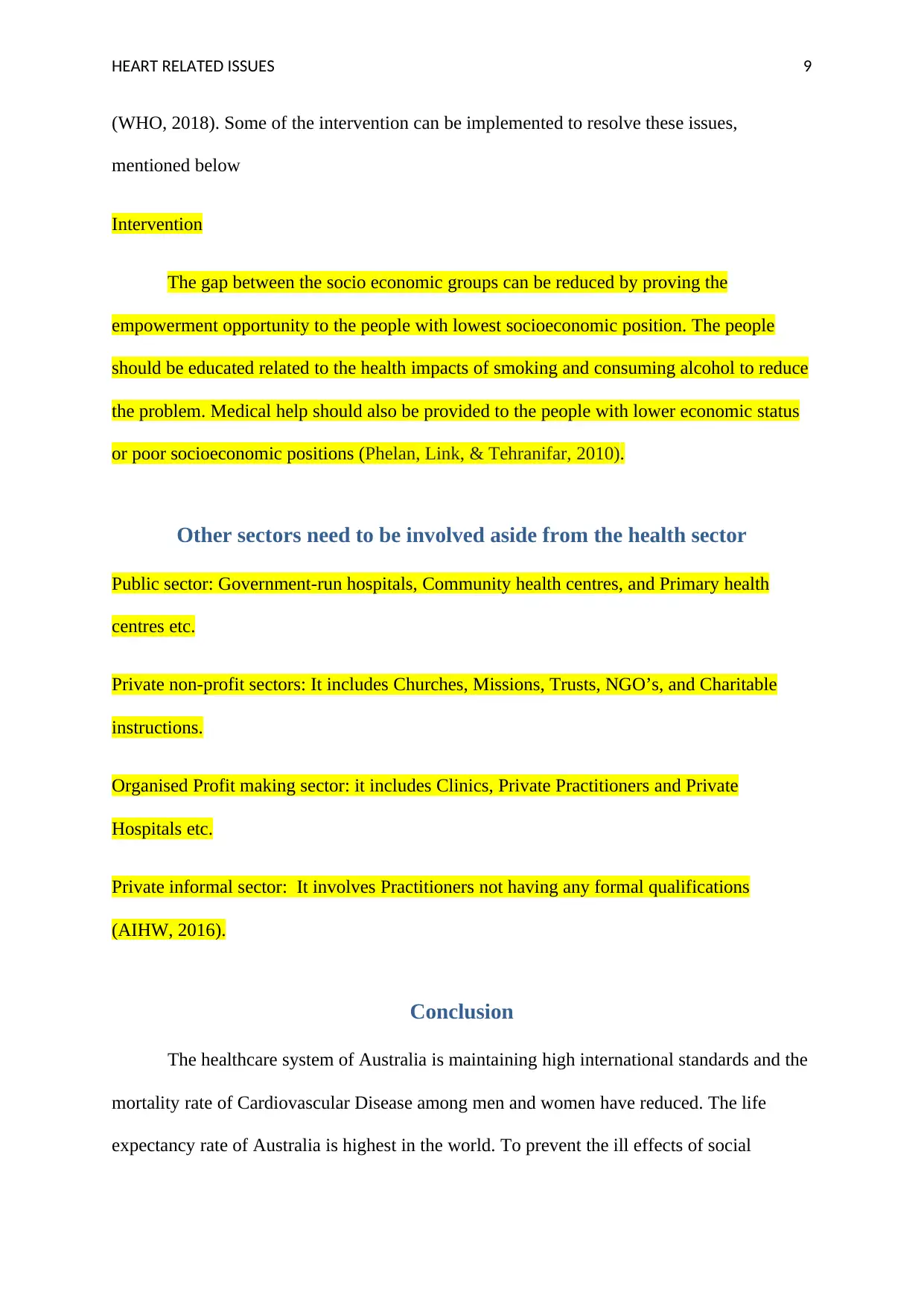
HEART RELATED ISSUES 9
(WHO, 2018). Some of the intervention can be implemented to resolve these issues,
mentioned below
Intervention
The gap between the socio economic groups can be reduced by proving the
empowerment opportunity to the people with lowest socioeconomic position. The people
should be educated related to the health impacts of smoking and consuming alcohol to reduce
the problem. Medical help should also be provided to the people with lower economic status
or poor socioeconomic positions (Phelan, Link, & Tehranifar, 2010).
Other sectors need to be involved aside from the health sector
Public sector: Government-run hospitals, Community health centres, and Primary health
centres etc.
Private non-profit sectors: It includes Churches, Missions, Trusts, NGO’s, and Charitable
instructions.
Organised Profit making sector: it includes Clinics, Private Practitioners and Private
Hospitals etc.
Private informal sector: It involves Practitioners not having any formal qualifications
(AIHW, 2016).
Conclusion
The healthcare system of Australia is maintaining high international standards and the
mortality rate of Cardiovascular Disease among men and women have reduced. The life
expectancy rate of Australia is highest in the world. To prevent the ill effects of social
(WHO, 2018). Some of the intervention can be implemented to resolve these issues,
mentioned below
Intervention
The gap between the socio economic groups can be reduced by proving the
empowerment opportunity to the people with lowest socioeconomic position. The people
should be educated related to the health impacts of smoking and consuming alcohol to reduce
the problem. Medical help should also be provided to the people with lower economic status
or poor socioeconomic positions (Phelan, Link, & Tehranifar, 2010).
Other sectors need to be involved aside from the health sector
Public sector: Government-run hospitals, Community health centres, and Primary health
centres etc.
Private non-profit sectors: It includes Churches, Missions, Trusts, NGO’s, and Charitable
instructions.
Organised Profit making sector: it includes Clinics, Private Practitioners and Private
Hospitals etc.
Private informal sector: It involves Practitioners not having any formal qualifications
(AIHW, 2016).
Conclusion
The healthcare system of Australia is maintaining high international standards and the
mortality rate of Cardiovascular Disease among men and women have reduced. The life
expectancy rate of Australia is highest in the world. To prevent the ill effects of social
Paraphrase This Document
Need a fresh take? Get an instant paraphrase of this document with our AI Paraphraser

HEART RELATED ISSUES 10
determinants on health the government has to introduce Whole-of-government approach, it is
suggested by WHO. The most common social determinant of heart disease is socioeconomic
status of people. With the help of the Whole of government approach, the country will reduce
out the effect of Social determinates and increase the efficiency of the health care system and
will succeed in providing equal health care to the population of the country. The intervention
can be beneficial to resolve the issues are reducing the gap by providing employment
opportunities to lowest economic groups, educating people about risk associated with
smoking and drinking alcohol, and providing medical help to the people with heart related
problems.
determinants on health the government has to introduce Whole-of-government approach, it is
suggested by WHO. The most common social determinant of heart disease is socioeconomic
status of people. With the help of the Whole of government approach, the country will reduce
out the effect of Social determinates and increase the efficiency of the health care system and
will succeed in providing equal health care to the population of the country. The intervention
can be beneficial to resolve the issues are reducing the gap by providing employment
opportunities to lowest economic groups, educating people about risk associated with
smoking and drinking alcohol, and providing medical help to the people with heart related
problems.
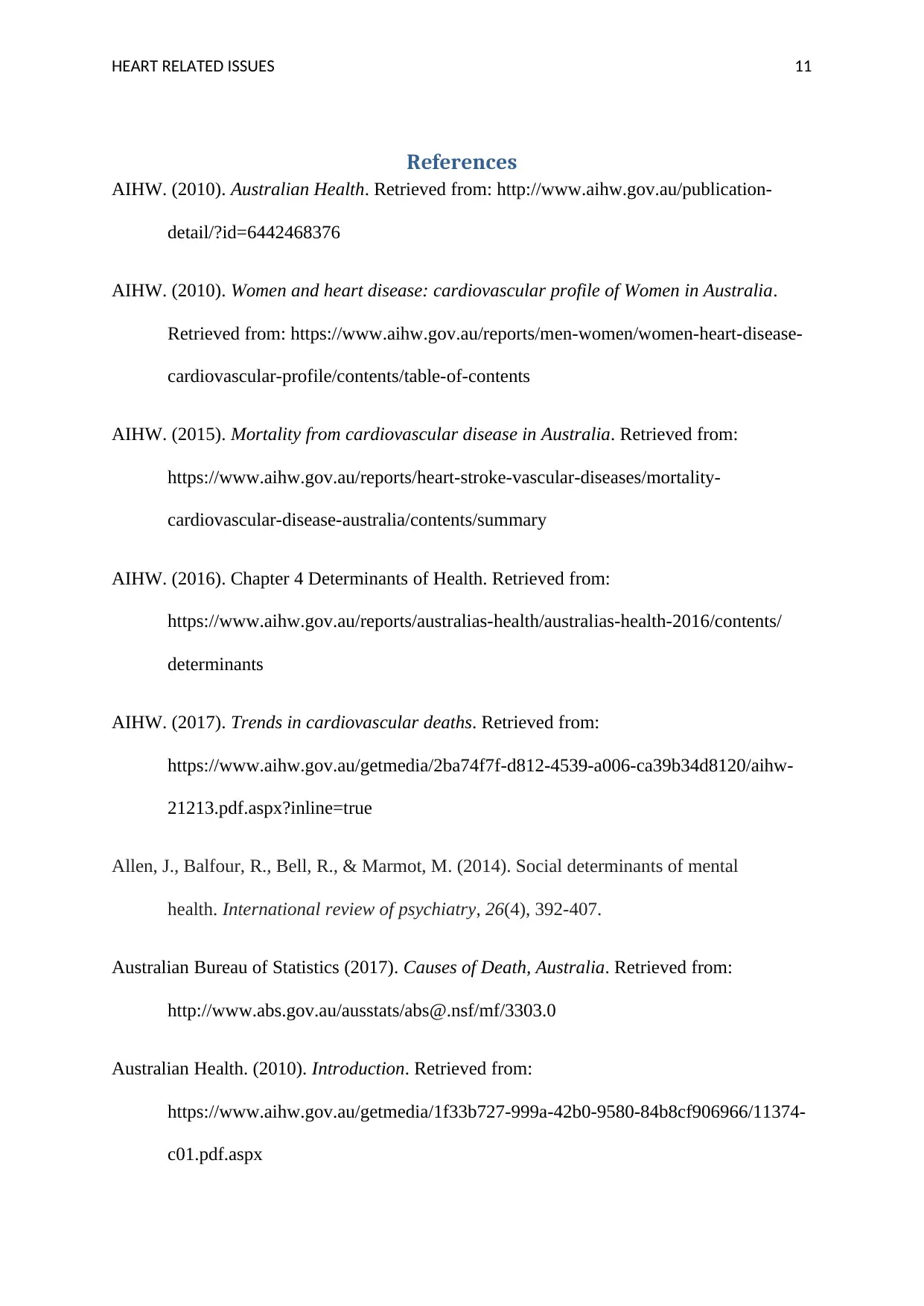
HEART RELATED ISSUES 11
References
AIHW. (2010). Australian Health. Retrieved from: http://www.aihw.gov.au/publication-
detail/?id=6442468376
AIHW. (2010). Women and heart disease: cardiovascular profile of Women in Australia.
Retrieved from: https://www.aihw.gov.au/reports/men-women/women-heart-disease-
cardiovascular-profile/contents/table-of-contents
AIHW. (2015). Mortality from cardiovascular disease in Australia. Retrieved from:
https://www.aihw.gov.au/reports/heart-stroke-vascular-diseases/mortality-
cardiovascular-disease-australia/contents/summary
AIHW. (2016). Chapter 4 Determinants of Health. Retrieved from:
https://www.aihw.gov.au/reports/australias-health/australias-health-2016/contents/
determinants
AIHW. (2017). Trends in cardiovascular deaths. Retrieved from:
https://www.aihw.gov.au/getmedia/2ba74f7f-d812-4539-a006-ca39b34d8120/aihw-
21213.pdf.aspx?inline=true
Allen, J., Balfour, R., Bell, R., & Marmot, M. (2014). Social determinants of mental
health. International review of psychiatry, 26(4), 392-407.
Australian Bureau of Statistics (2017). Causes of Death, Australia. Retrieved from:
http://www.abs.gov.au/ausstats/abs@.nsf/mf/3303.0
Australian Health. (2010). Introduction. Retrieved from:
https://www.aihw.gov.au/getmedia/1f33b727-999a-42b0-9580-84b8cf906966/11374-
c01.pdf.aspx
References
AIHW. (2010). Australian Health. Retrieved from: http://www.aihw.gov.au/publication-
detail/?id=6442468376
AIHW. (2010). Women and heart disease: cardiovascular profile of Women in Australia.
Retrieved from: https://www.aihw.gov.au/reports/men-women/women-heart-disease-
cardiovascular-profile/contents/table-of-contents
AIHW. (2015). Mortality from cardiovascular disease in Australia. Retrieved from:
https://www.aihw.gov.au/reports/heart-stroke-vascular-diseases/mortality-
cardiovascular-disease-australia/contents/summary
AIHW. (2016). Chapter 4 Determinants of Health. Retrieved from:
https://www.aihw.gov.au/reports/australias-health/australias-health-2016/contents/
determinants
AIHW. (2017). Trends in cardiovascular deaths. Retrieved from:
https://www.aihw.gov.au/getmedia/2ba74f7f-d812-4539-a006-ca39b34d8120/aihw-
21213.pdf.aspx?inline=true
Allen, J., Balfour, R., Bell, R., & Marmot, M. (2014). Social determinants of mental
health. International review of psychiatry, 26(4), 392-407.
Australian Bureau of Statistics (2017). Causes of Death, Australia. Retrieved from:
http://www.abs.gov.au/ausstats/abs@.nsf/mf/3303.0
Australian Health. (2010). Introduction. Retrieved from:
https://www.aihw.gov.au/getmedia/1f33b727-999a-42b0-9580-84b8cf906966/11374-
c01.pdf.aspx
⊘ This is a preview!⊘
Do you want full access?
Subscribe today to unlock all pages.

Trusted by 1+ million students worldwide
1 out of 14
Related Documents
Your All-in-One AI-Powered Toolkit for Academic Success.
+13062052269
info@desklib.com
Available 24*7 on WhatsApp / Email
![[object Object]](/_next/static/media/star-bottom.7253800d.svg)
Unlock your academic potential
Copyright © 2020–2025 A2Z Services. All Rights Reserved. Developed and managed by ZUCOL.





